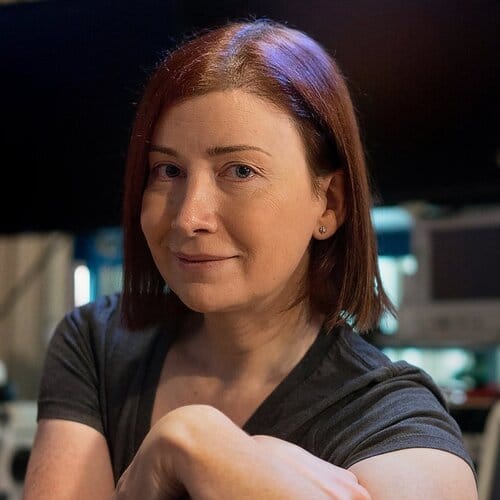
This article features the latest episode of The AR Show. Based on a new collaboration, episode coverage now joins AR Insider’s editorial flow including narrative insights and audio. See past and future episodes here or subscribe.
Early career lessons and experiences can often steer the direction of entrepreneurs’ paths — an ongoing theme in our coverage of The AR Show episodes. But no guest to date better embodies that principle than Tilt Five founder & CEO — and overall renaissance woman — Jeri Ellsworth.
Her path started with building race cars, including mechanical innovations that won several races in the car that she-herself drove. She then transitioned those mechanical skills to the safer — and it turns out more timely and opportune — path of computer hardware in the early 90’s.
That vaulted her into Silicon Valley where she got turned down for several jobs due to lack of a college degree. But when the big break came, previous rejections motivated her to not squander the opportunity. That drive, plus raw talent, led to a quick reputation as a rock-star engineer.
Overdrive
After some time doing contract work with gaming companies for exceptional engineering feats (you just have to listen), gaming powerhouse Valve came knocking. A full-court press to recruit Ellsworth was followed by her dream job to essentially run her own hardware innovation lab.
There, she got her first taste of VR, including the technology that would go on to become the HTC VIVE. But AR is what really got her excited, particularly related to a directive from Gabe Newell himself, to build something the whole family could play together (foreshadowing later adventures).
But when Valve decided to focus on VR only, Ellsworth’s job was axed, leading to an emotional but serendipitous crossroads. She bought the division’s IP and started Cast AR, only to see investors bring in seasoned execs that mismanaged and overleveraged the company into the ground.
Faced again with a crossroads, and an interim project in actual rocket science, Ellsworth bought the IP again. Tilt Five was born (see our separate writeup here). Going back to the theme of career lessons, a firm set of ethics — and investor selectivity — were established at the outset this time.
“In the last couple years putting Tilt Five together, it’s been challenging,” said Ellsworth. “I learned so many lessons about raising money and who to take money from. I had to walk away from a lot of money, as soon as they started using code words that were indicating they were going to try to do certain things in the company… There were points in the last couple of years when we were just a couple weeks from not having money to pay people. And I just had to come back to the team and say ‘we can’t do this deal. I’m sorry guys, we may crash and burn but, we better crash and burn now than crash and burn by taking their money.’ And I put it into overdrive, went out found the money to keep us in business and we kept going.”
Kickstart
Another important lesson that was applied to Tilt Five was product focus. Instead of going after too many markets — a culprit of Cast AR’s downfall — Tilt Five’s strategy is and has been to zero in on nailing a specific experience. And that starts with socially-oriented tabletop gaming.
“We decided to subdivide all the markets we could go after, and be super focused on one and just nail it as best we could, then expand from there. And we decided to do tabletop entertainment. There are a lot of decisions that went into that. One of them was we could go try to take on Xbox, and we do great video games on our system. But there’s no way we can compete against a company putting a billion dollars into a single product. But we can compete in the $7 billion tabletop market where we let people work with their cardboard pieces and plastic pieces… we can wrap it with graphics, we can allow people to connect game boards together and have virtual game boards over long distances.”
Speaking of messaging, Tilt Five deviated from a lot of tech companies, especially in the XR sector, by focusing on the user experience rather than tech specs. This led to the enormously successful Kickstarter campaign that quadrupled its funding goal and brought in $1.77 million.
The strategy was also to make the product approachable by meeting users halfway with AR integrations that enhance something that’s already familiar. This is the “training wheels,” concept that we’ve been writing about, including our 2020 predictions. It will be a key AR success factor.
The first thing is we’re not replacing the board game experience… we’re adding a new dimension to it… We take all the things that you love about video games and all the things that you love about board games and blend those together. There’s a constant spectrum between a pure video game — we can do a completely holographic tabletop game — And old- school pen and paper, cardboard and plastic pieces. We can live anywhere in that spectrum. We’re actually partnered with a company called Fantasy Grounds, which has thousands of D&D and Pathfinder-like campaigns. You can download maps, and then the guides help you walk through. Hundreds of thousands or millions of users already using their platform… now we just expand on it.”
Virtuous Cycle
Another product attribute goes back to Ellsworth’s early directive at Valve to build something that the whole family can play together. Tilt Five is a social experience at heart and moreover, it can “placeshift” players together, which enhances not only experience but addressable market.
“I like to play board games, but I can’t ever get my friends to all show up at my house at the same time… And that’s a big barrier for me to play. But if we virtualize a bunch of the stuff, I can connect my game board with their game board and play over the internet. So I can just call my buddies up and say, ‘hey, let’s play a game of Catan.’ And we just link our game boards now we have this shared 3D space between our homes. And because we have all this advanced tracking technology, we actually can make it feel like you’re in the same room together. So as I move my hands through this volumetric space, I can have an avatar of my hand. We have microphones and speakers, so I can be talking to my friends and be like… hey, I just blew up your village… all the things that you would do normally when you’re face to face.”
The other principle this builds on is the social appeal of gaming. In examining video games for years, Ellsworth has tracked a trend towards social interaction. This means any game that builds on this dynamic can benefit from social’s growing appeal, not to mention a built-in network effect.
This can also jumpstart a virtuous cycle where more users provide greater incentive for developers to build games. Those expanding libraries then attract more users who in turn attract more developers. So selling headsets in bundles can obviously accelerate that process.
“We believe the real interesting piece of this is bringing the whole family together. And that’s going to be selling like two or three headsets… So one of the things that we wanted to prove with this is that people would be willing to buy multiples, to have that social experience and right now we’re averaging over two units per [kickstarter] backer. So we have completely succeeded in proving that people are willing to pay for this social gaming experience… There’s been this trend that I’ve been watching since I’ve been at Valve… At the time, it was about 40 percent of people [that] get online and play games to be social. And that number has almost topped 70 percent now. And so you have games like Fortnight, where kids go into the games and they don’t even like play the game the way it’s supposed to be played. They hang out in the lobby.”
Multiple headset sales also boost Tilt Five’s margins. This comes down to unit economics in driving average revenue per user (ARPU) and greater margins at higher volumes. Underlying this are typical hardware challenges, versus software, as atoms are more capital intensive than bits.
Built to Last
As for what the future holds, though Ellsworth is big on the idea of product focus as explicated above, the technology can grow in many directions. Tabletop gaming is a starting point but there are many areas to which the underlying technology can apply. It is a developer platform after all.
Ellsworth is likewise big on the idea of “AR somewhere” versus “AR everywhere,” in the near term. But she’s excited about the long term prospects for the latter. And Tilt Five will be primed for that evolution, as AR’s natural arc is built into the company’s long-term road map.
“I think that near-eye optics is going to take a minimum four or five years before we start to see traction in that space. And in that four or five-year span, I want to see as much utility as we can pack into the tabletop. There’s going to be professional use cases, gaming use cases, educational use cases. And so we can just keep growing this tabletop experience almost indefinitely for the next half-decade or more. But eventually, we’re going to be able to lift users off the table. And then those same kinds of utilities will be with you around your home or office. So I think there’s this long tail of utility and it’s going to take a long time. But one day in a decade or decade and a half, we’re going to wake up, slip on our Tilt Five AR-everywhere glasses, and we’re using it for everything in our life.”
Listen or subscribe to the full episode at The AR Show or below, and see our archive of past and future episode coverage here.
For deeper XR data and intelligence, join ARtillery PRO and subscribe to the free AR Insider Weekly newsletter.
Disclosure: AR Insider has no financial stake in the companies mentioned in this post, nor received payment for its production. Disclosure and ethics policy can be seen here.









